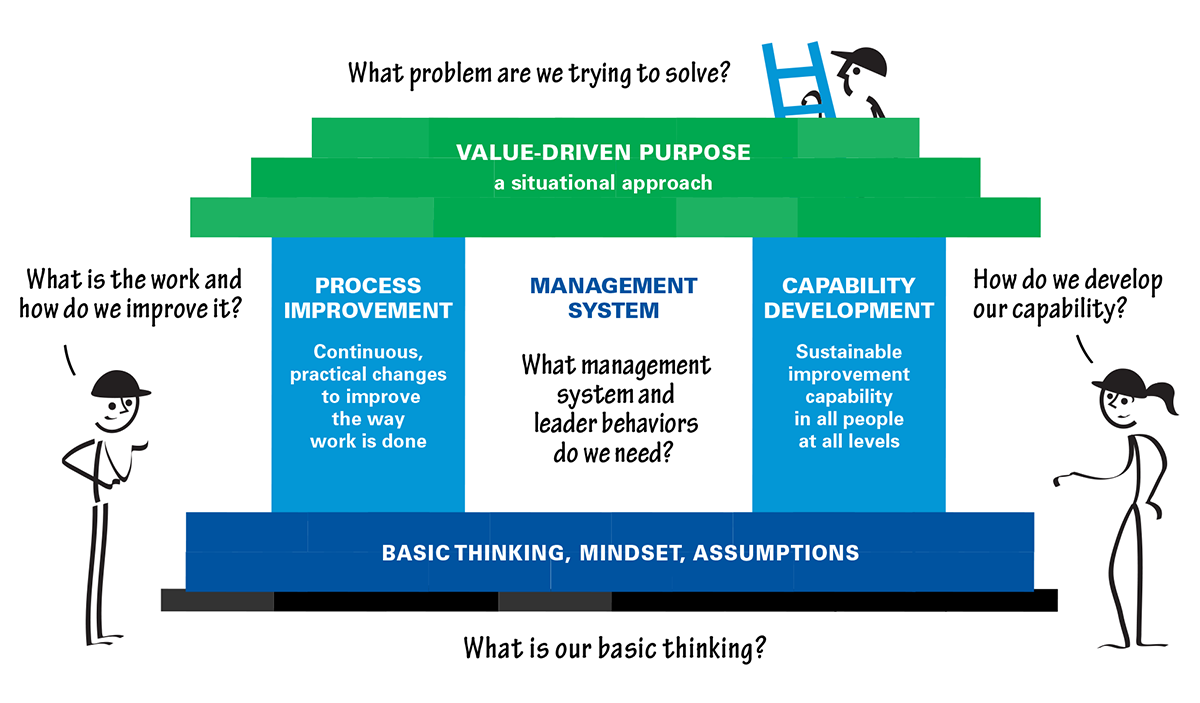The following video guides you through the Lean Transformation Framework, a proven, systematic approach toward achieving a lean transformation by resolving problems at every enterprise level, from executive-level strategy to frontline operations. Find a lightly edited transcript below.
At the Lean Enterprise Institute, we think a lot about change. We think a lot about enterprise transformation. Every day all day, each of us aspires to create desired change. That’s what work is all about.
Enterprise transformation, then, is change on the enterprise level.
We’ve learned a lot over the years. But, most critically, we have learned that effective enterprise transformation requires change — innovative improvement — on five dimensions. That is a bold assertion: not four, not six, but five dimensions. And lean thinking has a point of view about each of those five dimensions.
We’ll not delve deeply into what those points of view are right now. Instead, we will explore the essential matter of how to think about enterprise change through the illustration of a house. The metaphor of a house has been around lean thinking for a long time, so we’ll use that for convenience.
Determining Your Value-Driven Purpose
Let’s start with the roof to explore it. Any good house has to have a roof to protect us from the rain, sleet, and maybe excessive sunshine — if there could be such a thing. At the top of this house, we have our objectives — our goals, our aspirations. In other words, we’re going to ask: What is our value-driven purpose — why are we here — as a company, as an enterprise? It may be we would think we’re here just to generate money. That would take us down a certain path, in which case I may care less about creating customer value and may care just about profit.
Lean thinking drives us to think about what value we create for customers, society, and employees. So, what is our value-driven purpose?
Since it (lean thinking) starts with a question like that, our approach to effective transformation should be situational. It’s a situational approach determined by first asking the question: What is our value-driven purpose? More specifically, each individual in your organization needs to be able to ask and answer the question: What problem am I here to solve? What problems are we each trying to solve?
Identifying the Work to be Done and Processes to Improve
The next question to ask is What is the work to be done? What is the work?
Any house has to have walls, or pillars, to hold up the roof. This first pillar represents the work to be done. We call it Process: What is the process, or the work, by which we will accomplish our purpose?
If our purpose is to create videos, we have to know how to get a video camera, then set it up so that we have the proper lights and can get the work done. Then, as we gain experience, we will doubtless find that there are problems in the work process — that the work needs to be improved. So, we need some means by which we go about process improvement.
Improving the work to done — always starting with the work. What is the work to be done? So now that I’ve identified the work that’s going to solve the problem to deliver the value we’re here to provide, that’s the first pillar to hold up the roof.
Specifying the Capabilities that are Needed
The roof will not be held up by only one pillar; we have to have another. And we’re going to call this one Capability. This pillar is understood by asking: What capabilities do we need to do the work — to solve the problem and fulfill our purpose?
Capability-building thus comprises the other pillar, the second pillar. So, with these two pillars, I now have something holding up my roof, making it look like a house.
Creating the Management System
But any house is only a house until it’s a home. It becomes a home by the behavior of the people living in it. The people are inside, not outside, and so are protected and comforted by the house and the dynamic that brings the place to life — to make it into a home. And there are two aspects of that we to consider.
The first is the management system that I can define that will support the development of building capabilities to do the work to fulfill the purpose. And the second is the behaviors — soft skills — required of leaders and everyone for us to be able to work effectively within this management system (to build the capability to do the work to fulfill the purpose). So, we need to define those soft skills, those behaviors. For example, how might I respond as a leader when one of my employees or one of my team members has a problem or has made a mistake? Do I get angry? Do I throw things? Or do I seek to understand why, so I can help remove the barriers to that employee’s success?
The management system, then, is something I can define just as I define a mechanical device. Let’s say, for example, that we’ll meet every morning in a huddle at 8 o’clock. And then, we’ll meet again before lunch to see how the day has gone so far. We’ll have weekly meetings to assess and determine our plans for the week. We’ll meet monthly to see how we’re doing against our annual plan and annually to develop a plan that will take our organization further toward achieving our defined purpose. So the management system can be defined. The management system and the behaviors — the leader behaviors and the teamwork behaviors — of everyone are those soft skills that fit in and bring this overall system to life.
Developing Your Basic Thinking
One more dimension to our enterprise transformation model is underneath all of this. Basic thinking, or mindset or underlying assumptions, informs everything we do — informs all of our activities as we attempt to achieve our purpose.
Basic thinking and some other words I’ll use interchangeably here — mindset, underlying assumptions, beliefs — can be of two types: Explicit assumptions that we articulate and hidden underlying assumptions that we are unaware of on a moment-to-moment basis. These underlying beliefs comprise our current culture as it exists today, which we can change to achieve the ideal culture to which we aspire. Understanding our current and aspirational culture will give us a gap to close, just as we can identify gaps in other parts of our enterprise performance as we solve problems day to day.
Moving Forward Situationally
So all together, these are things we need to address. And around each of these, I can ask some simple questions: What problem are we trying to solve? What purpose are we trying to achieve? What is the work to be done, and how will I go about improving it? What capabilities are required, and how will I grow them? What management system can I define, and what behaviors are needed to build the capabilities to do the work to solve the problem that we’re here to solve? And underneath it all is the matter of addressing: What is our basic thinking? What do we currently think, for example, about cause and effect? How is that thinking currently comprised in our culture, and how does that affect the culture we want to create?
Addressing these dimensions leads us toward effective enterprise transformation. If we leave any out, we’ll fail, So the Lean Transformation Framework is a situational approach because there is no perfect ten-step program that leads to the perfect lean transformation. Each situation is unique and demands its own customized set of countermeasures.
With the questions on the five dimensions, however, we each can map out our own personal or organizational transformation, one that solves our specific situational problems to achieve our unique purpose.
Good luck on your journey.
Learn more about the Lean Transformation Framework.
Key Concepts of Lean Management
Get a proper introduction to lean management.





I particularly enjoy the ‘Creating the Management System’ portion. In my opinion, the rest can be done away with, even at the most basic level until this section is in order; you can lead a horse to water. In my opinion (backed with the most limited experience and book knowledge) you can have the leanest thinking in the world, but if everyone is not oriented toward the same goal and does not have faith in the same behaviors, then practices fizzle, and goals are left unaccomplished. Every business is the business of people as far as I’m concerned, and its about knowing what makes them tick.